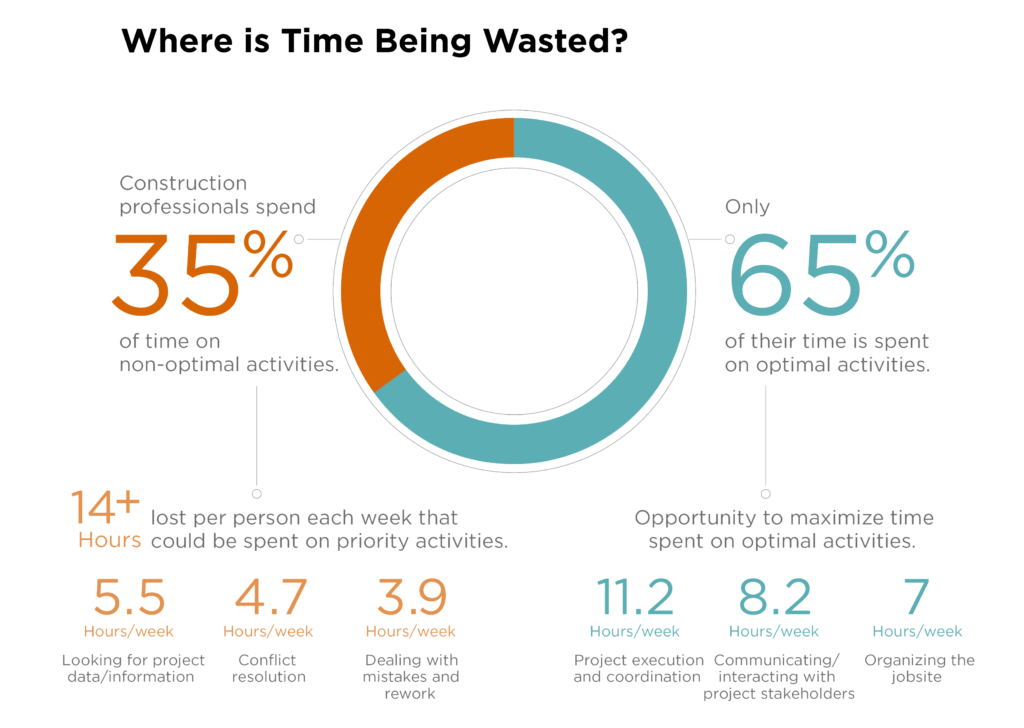The construction industry is going through a major shift thanks to the power of connected data. With projects becoming more complex, linking data across all stages—design, planning, procurement, construction, and operations—has become essential. Yet, many companies still face the problem of disconnected data, which can lead to lost productivity, missed deadlines, cost overruns, delays, and, potentially, the dreaded litigation phase.
The Cost of Disconnected Data
Historically, construction has had a fragmented data landscape. Different teams and stakeholders often operate in isolation, using disparate systems and processes to manage their specific project segments. When data is scattered across different systems and formats, it becomes challenging to access and utilize effectively. Teams spend excessive time searching for information, leading to delays, missed deadlines, and decreased productivity. Without a unified data system, tracking expenses and managing budgets is difficult, often leading to unexpected costs and financial inefficiencies. Managing project schedules with disconnected data makes it challenging to monitor progress accurately and make timely adjustments, often resulting in schedule overruns and prolonged project timelines.
According to the Construction Disconnected industry report, construction professionals spend on average 35% of their time on non-optimal activities. This equates to over 14 hours per person each week that could be spent on priority tasks. If you dive deeper into those numbers, the report states that 5.5 of those 14 hours are spent looking for project data/information, 4.7 are spent on conflict resolution, and 3.9 are spent dealing with mistakes and rework. This amount of wasted time equates to a brutal figure of $177.5 billion spent in labor costs on non-optimal activities, according to PlanGrid & FMI (2018).

The report also found that on average 48% of all rework in the US construction industry is caused by poor data and miscommunication. This rework costs the industry a total $65 billion by year’s end, with $31.3 billion of rework being due to poor data and miscommunication according to PlanGrid & FMI (2018). “To further break down the $31.3 billion that is wasted on rework in the US-when asked what they attribute rework to on projects, 22% of respondents pointed to poor project data and 26% cited poor communication among stakeholders. When viewing each item as individual contributors to rework, poor communication represents an annual cost of $17 billion to the US construction industry and poor project data represents $14.3 billion. The remaining 52% of rework could be caused by several other factors including design changes or issues, faulty or delayed materials, unforeseen conditions and more” (PlanGrid & FMI, 2018).

The Promise of Connected Data
As project complexity has increased since the study, the challenges have become even more pronounced. In fact, another study between Autodesk and FMI found that in 2020, bad data cost the global construction industry over $1.84 trillion (Autodesk & FMI, 2020). The silver lining here is that these heavy costs to the industry in terms of time, labor, money, and risk can be largely addressed by, you guessed it, better connected project data. Connected data transforms isolated silos into a single source of truth. By integrating data from various sources, it ensures all stakeholders have access to the same up-to-date information, increasing collaboration, transparency, accountability, and efficiency.
Key Benefits of Connected Data
When teams have a single source of truth to work from, they tend to see an increase in collaboration, efficiency, safety, and more. The following are key benefits connected data brings to construction teams.
- Improved Efficiency: Having the right info at your fingertips is a game-changer for getting things done. When everyone knows what fires to put out and has the facts to back up their calls, work flows smoother. Communication occurs and is based off a single source of truth where all data and information are available to facilitate conversations.
- Smarter Designs: Designers gain real-time access to project data, enabling seamless coordination with teams to deliver designs that meet client needs. Likewise, construction teams benefit from shared insights with the design department, allowing for better alignment. This promotes more effective planning across teams, ensuring a cohesive approach rather than isolated efforts.
- Cost Savings: With connected construction data, your team can catch and resolve issues throughout the workflow instead of at the project’s end. Instant access to the latest data ensures tasks are done right the first time, preventing expensive and exhausting rework. Additionally, administrative costs are reduced by eliminating paper and memory devices, with all information easily accessible and searchable in the cloud.
- Enhanced Safety Planning: Connected data enables construction companies to maximize their return on investment in employee safety management. Enhanced designs and installation planning lower the risk of on-site accidents and injuries. Both preconstruction and construction teams can use historical and real-time data to spot and address safety risks. This data can also be used to create more efficient safety plans and checklists, improving overall safety management.
- Stronger Client Experiences: Improved decision-making benefits clients as well. Involve them at key stages of the design process for feedback and adjustments. At handover, share project insights and data via an integrated technology platform to boost operational readiness. This also provides a structured record of testing, commissioning, warranty, asset information, and project data, creating an audit trail that helps minimize post-completion disputes.
The Path Forward
As the construction industry takes on the next digital transformation, embracing connected data will be key. By linking data across the board, we’re looking at better projects, happier clients, safer sites, and stronger businesses. In short, connected data isn’t just nice to have – it’s becoming essential to stay competitive.
At Team D3, we specialize in providing cutting-edge digital BIM, project delivery, and lifecycle solutions tailored to the unique needs of the construction industry. Our expertise in connected data solutions ensures that your projects benefit from the latest technological advancements, helping you stay ahead of the curve and achieve long-term success. Partner with us to unlock the full potential of connected data and transform how you manage and execute your construction projects. If you’re interested in learning more about how Team D3 can help your firm with a connected data strategy, reach out to Craig.Boklage@teamd3.com.
Autodesk, & FMI. (2020). Harnessing the data advantage in construction: Why adopting a data strategy can bring firms a competitive edge. Autodesk Construction Solutions.
PlanGrid, & FMI. (2018). Construction Disconnected: Rethinking the management of project data and mobile collaboration to reduce costs and improve schedules. PlanGrid.




